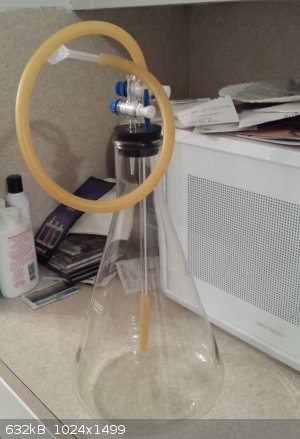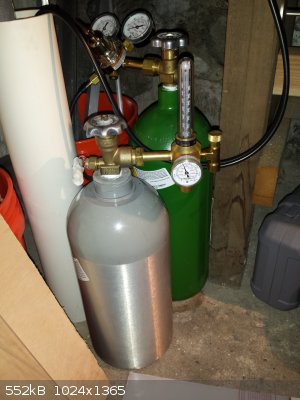sbreheny
Hazard to Others
  
Posts: 145
Registered: 30-1-2014
Member Is Offline
Mood: No Mood
|
|
Argon density
Hi all,
Just wanted to share a quick bit about an experiment I did which was nothing spectacular or original but still interesting and a learning experience
for me about gas mixing.
I did an experiment tonight to see if I could fill a flask with argon gas and measure the density of the gas. To make it easier to weigh the gas, I
used a 3 liter flask. The procedure was to outfit the flask with input and output valves, the input valve having a long tube extending down almost to
the bottom of the flask and the output having a much shorter one. The input is loosely adapted to the output of the regulator on the argon cylinder
with a tiny plastic funnel - which also provides a natural pressure relief valve since I am holding it on the regulator output. Then, I weighed the
whole setup (with air in it), tared the scale, and then filled it with argon. Filling with argon was done by opening both valves and flushing out the
flask for a full 5 minutes and tilting it to different orientations to ensure good gas mixing. Then, I closed the output valve first and then the
input valve, building up a few PSI of positive pressure inside the flask. When I put it back on the scale, the last thing I did was open one of the
valves and release the pressure and wait for the measured weight difference to stabilize. It was 1.71 grams, out of a total mass of about 880 grams. I
measured the exact volume of the total flask using water - it was 3.86 liters. This volume of air weighs 4.516 grams at the present conditions in the
room, so the argon weighed 6.226 g, giving a density of 1.613 g/liter. The textbook value for these conditions of temperature and pressure is 1.65
g/liter. Pretty close! I had to do the experiment three times because it was actually very difficult to flush all the air out of the flask. I kept
getting values which were too low. That's why I eventually flushed it for a full 5 minutes, even though that used a few dollars worth of argon.
In the photo of the cylinders, the green one is oxygen for a glassworking/light welding torch. The one in the foreground is argon, with a
flowmeter-regulator.
Sean
 
|
|
|
annaandherdad
Hazard to Others
  
Posts: 387
Registered: 17-9-2011
Member Is Offline
Mood: No Mood
|
|
It would help understanding results like this if you had estimates for the errors in each of your measured quantities, for example, the volume of the
flask.
I assume your value for the weight of the air in the flask was theoretical. It was probably an overestimate, due to water vapor. This would cause
your estimated weight of the argon to be too high. Also, when you measured the volume of the flask, did you take into account the stopper and the
glass tubes?
Uniformity of temperature would be important. One degree C error would cause an error of 0.3% in the results. You're quoting the weight of the argon
to an apparent accuracy of about .02%.
It's hard to make very accurate measurements. Here the main problem is the subtraction of the large mass of the flask to get the mass of the gas.
Your scale would have to be accurate to one part in 10^4 to get an accuracy of 1 part in 25 (4%) for the mass of the gas. Your actual error, if all
your figures are correct, is about this amount.
Any other SF Bay chemists?
|
|
|
Tsjerk
International Hazard
    
Posts: 3022
Registered: 20-4-2005
Location: Netherlands
Member Is Offline
Mood: Mood
|
|
Taking in account all of Anaandherdad's comments, I would be pretty pleased with the measurements you did!
|
|
|
|